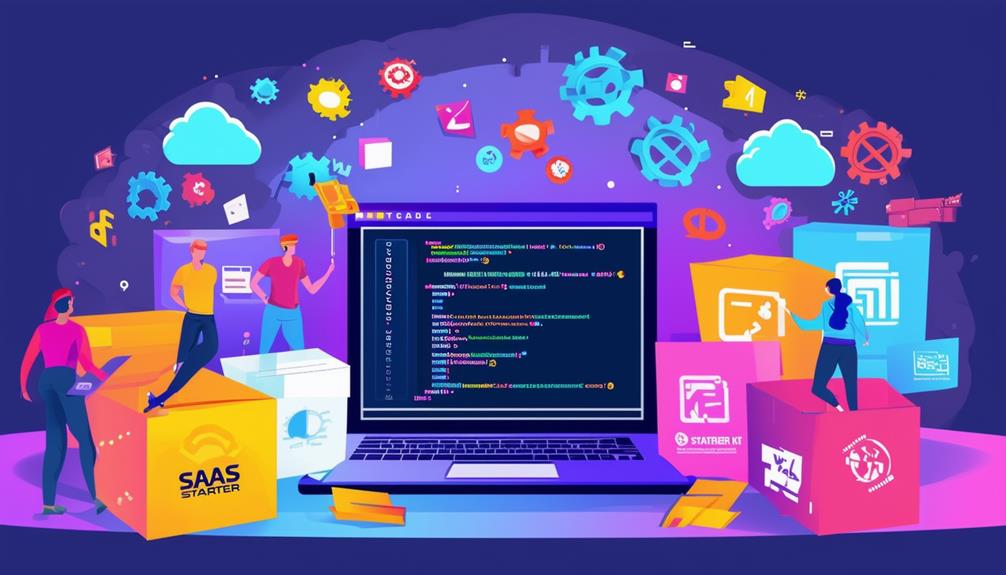When you’re considering SaaS starter kits for your business, you’re faced with a vital decision that can impact your company’s future growth and success. With the global SaaS market projected to reach $307 billion by 2026, it’s important to choose a solution that aligns with your specific needs and goals. You’ll need to evaluate core functionalities, technical compatibility, and scalability options while keeping an eye on cost-effectiveness and user experience. But how do you navigate the myriad of options and guarantee you’re making the right choice? The key lies in a systematic approach that considers several essential factors.
Defining Your Business Requirements
Before diving into SaaS starter kits, you’ll need to clearly define your business requirements to guarantee the solution you choose aligns with your specific needs and goals. Start by identifying your core functionalities, such as user authentication, payment processing, or data analytics. Prioritize these features based on their importance to your business model and target audience.
Next, consider your scalability needs. Analyze your projected user growth and data volume to ascertain that the starter kit can accommodate future expansion. Evaluate your technical resources and determine if you’ll need a solution that’s easy to customize or if you have the expertise to modify more complex systems.
Don’t forget to assess your budget constraints and time-to-market requirements. Some starter kits offer rapid deployment but may limit customization, while others provide more flexibility at the cost of longer development cycles. Consider your integration needs with existing tools and third-party services to guarantee seamless workflow.
Lastly, factor in your compliance and security requirements. If you’re handling sensitive data or operating in regulated industries, look for starter kits that offer robust security features and compliance certifications.
Assessing Technical Compatibility
Once you’ve defined your business requirements, it’s important to assess the technical compatibility of potential SaaS starter kits with your existing infrastructure and development stack. This step guarantees seamless integration and minimizes future complications.
Start by evaluating the programming languages and frameworks used in the starter kit. Compare these with your team’s expertise and your current tech stack. According to a 2022 Stack Overflow survey, JavaScript, HTML/CSS, and Python are the most popular languages among developers, so kits using these may offer wider compatibility.
Next, examine the database systems supported by the kit. Confirm they align with your data management needs and scalability requirements. MongoDB and PostgreSQL are common choices in SaaS environments, with 26% and 40% market share respectively.
Consider the deployment options offered. Cloud-native solutions compatible with major providers like AWS, Google Cloud, or Azure can greatly reduce hosting complexities. 94% of enterprises already use cloud services, making this a vital factor.
Lastly, assess the kit’s API integrations and extensibility. Look for pre-built connections to popular third-party services and the ability to add custom integrations. This flexibility can save up to 60% in development time and costs.
Evaluating Scalability Options
Regularly reviewing a SaaS starter kit’s scalability options is essential for guaranteeing your product can grow alongside your user base and business needs. When evaluating scalability, focus on three key areas: infrastructure, database, and application architecture.
First, examine the kit’s infrastructure scalability. Look for cloud-native solutions that support auto-scaling and load balancing. These features allow your system to automatically adjust resources based on demand, guaranteeing peak performance during traffic spikes. According to a recent study, 78% of successful SaaS companies prioritize cloud-native scalability.
Next, analyze the database scalability. Confirm the kit supports horizontal scaling through sharding or read replicas. This enables your database to handle increasing data volumes and concurrent users efficiently. Consider NoSQL options for improved flexibility and performance at scale.
Lastly, evaluate the application architecture’s scalability. Look for microservices-based designs that allow individual components to scale independently. This approach can lead to a 35% improvement in resource utilization compared to monolithic architectures.
Analyzing Cost-Effectiveness
When it comes to SaaS starter kits, analyzing cost-effectiveness is essential for maximizing your return on investment and ensuring long-term profitability. To evaluate cost-effectiveness, you’ll need to take into account both upfront and ongoing expenses.
Start by comparing the initial licensing fees of different starter kits. Factor in any additional costs for customization, integration, and training.
Next, assess the monthly or annual subscription fees, which often vary based on features and user count. Don’t forget to calculate potential savings in development time and resources.
Examine the total cost of ownership (TCO) over a 3-5 year period. This should include maintenance, upgrades, and potential scalability costs. Compare this TCO against projected revenue and growth metrics to determine the kit’s long-term value.
Reflect on the kit’s impact on customer acquisition costs (CAC) and lifetime value (LTV). A well-designed starter kit can reduce onboarding time and improve user experience, potentially lowering CAC and increasing LTV.
Examining Customization Capabilities
Beyond cost considerations, a SaaS starter kit’s customization capabilities can greatly impact its value and long-term viability for your business. When evaluating these kits, focus on the level of flexibility they offer in adapting to your specific needs. Look for features that allow you to modify user interfaces, workflows, and data structures without extensive coding.
Key customization aspects to assess include:
- White-labeling options: Can you easily brand the solution with your company’s logo and colors?
- API integration: Does the kit offer robust APIs for connecting with other tools in your tech stack?
- Extensibility: Can you add custom modules or features as your business grows?
- Template customization: Are there editable templates for emails, reports, and dashboards?
Analyze the documentation and support resources provided for customization. A well-documented kit with clear guidelines can markedly reduce implementation time and costs.
Additionally, consider the kit’s community and ecosystem. Active user forums and third-party integrations often indicate strong customization potential.
Reviewing Security Features
Security features stand out as a vital factor in choosing a SaaS starter kit, directly impacting your product’s reliability and user trust.
When evaluating these features, focus on encryption standards, authentication mechanisms, and data protection measures. Look for kits that offer industry-standard encryption protocols like AES-256 for data at rest and TLS 1.3 for data in transit.
Assess the authentication options provided, such as multi-factor authentication (MFA) and single sign-on (SSO) capabilities. These features enhance user security and streamline access management. Additionally, examine the kit’s compliance certifications, such as SOC 2, ISO 27001, or GDPR readiness, which demonstrate a commitment to data protection and privacy.
Consider the kit’s approach to role-based access control (RBAC) and how it handles user permissions. A robust RBAC system allows for granular control over user access, reducing the risk of unauthorized data exposure.
Finally, evaluate the kit’s logging and monitoring capabilities. These features are essential for detecting and responding to potential security threats, ensuring your SaaS product remains secure and trustworthy.
Considering Integration Possibilities
Integration capabilities are an essential factor in selecting a SaaS starter kit, as they’ll determine your product’s ability to connect with other tools and expand its functionality. When evaluating starter kits, focus on their API support, webhook capabilities, and pre-built integrations with popular services.
Look for kits that offer robust REST APIs, allowing seamless data exchange with external applications. GraphQL support is a bonus, offering more flexibility in querying data. Check if the kit provides thorough API documentation and SDKs in multiple programming languages to ease development.
Assess the starter kit’s webhook system, enabling real-time event notifications to third-party services. This feature is critical for creating automated workflows and keeping external systems updated.
Examine the list of pre-built integrations offered. Prioritize kits that connect with widely-used tools in your industry, such as CRM systems, payment gateways, and analytics platforms. This can greatly reduce development time and costs.
Consider the kit’s extensibility. Look for modular architectures that allow easy addition of new integrations. Some kits offer marketplace functionality, enabling third-party developers to create and sell add-ons, potentially increasing your product’s value proposition and market reach.
Exploring User Experience Design
When evaluating SaaS starter kits, you’ll need to carefully assess their user experience (UX) design capabilities, as they’ll directly impact your product’s adoption and user satisfaction rates. Look for kits that offer intuitive navigation, responsive layouts, and customizable interface elements. These features can notably reduce your time-to-market and development costs.
Analyze the kit’s UX design patterns and verify they align with current industry standards. A well-designed starter kit should provide a solid foundation for creating user-friendly interfaces that cater to your target audience’s needs. Pay attention to accessibility features, as they’re vital for reaching a wider user base and complying with regulations.
Consider the kit’s ability to support A/B testing and user behavior analytics. These tools will help you make data-driven decisions to optimize your UX continuously. Additionally, evaluate the kit’s design system and component library. A thorough set of pre-built, customizable components can accelerate your development process and maintain consistency across your application.
Lastly, check if the kit offers user onboarding features like tooltips, guided tours, or contextual help. These elements can notably improve user adoption rates and reduce support tickets, ultimately boosting your SaaS product’s success.
Investigating Support and Documentation
Thorough support and documentation are critical factors you’ll need to evaluate when assessing SaaS starter kits, as they can greatly impact your development speed and product quality.
Start by examining the kit’s documentation breadth and depth. Look for extensive API references, clear setup instructions, and detailed guides for common use cases. A well-documented starter kit can reduce your team’s learning curve by up to 40%.
Next, evaluate the support channels available. Does the kit offer community forums, direct email support, or even live chat? Research response times and user satisfaction rates. Kits with active communities often see 30% faster issue resolution times.
Additionally, check for regular updates and maintenance. A kit that’s frequently updated demonstrates ongoing support and can save you from potential security vulnerabilities.
Consider the availability of video tutorials, code samples, and interactive demos. These resources can boost developer productivity by 25%.
Finally, assess the kit’s compatibility with popular development tools and frameworks. Integration ease can greatly reduce your time-to-market.
Testing Performance and Reliability
You’ll need to immerse yourself in rigorous performance and reliability testing to guarantee your chosen SaaS starter kit can handle real-world demands and scale effectively.
Start by simulating various user loads, from a handful to thousands of concurrent users, to evaluate how the system responds under pressure. Monitor key metrics like response times, server CPU usage, and memory consumption to identify potential bottlenecks.
Next, evaluate the kit’s scalability by testing its ability to handle increased data volumes and user growth. This includes analyzing database performance, caching mechanisms, and load balancing capabilities.
Don’t forget to examine the kit’s resilience to failures by simulating server outages or network disruptions.
Benchmark the starter kit against industry standards and your specific performance requirements. Pay close attention to areas critical for your business, such as transaction processing speeds or real-time data synchronization.
Additionally, evaluate the kit’s compatibility with various browsers, devices, and operating systems to guarantee a consistent user experience across platforms.
To Wrap Up
You’ve now got the tools to make an informed decision on SaaS starter kits for your business. Remember, it’s all about aligning with your specific needs and growth plans.
Don’t skimp on security, user experience, or scalability. By thoroughly evaluating these aspects, you’ll maximize ROI and set your business up for success.
Take the time to test, compare, and analyze – it’ll pay off in the long run with a solution that truly fits your business.






